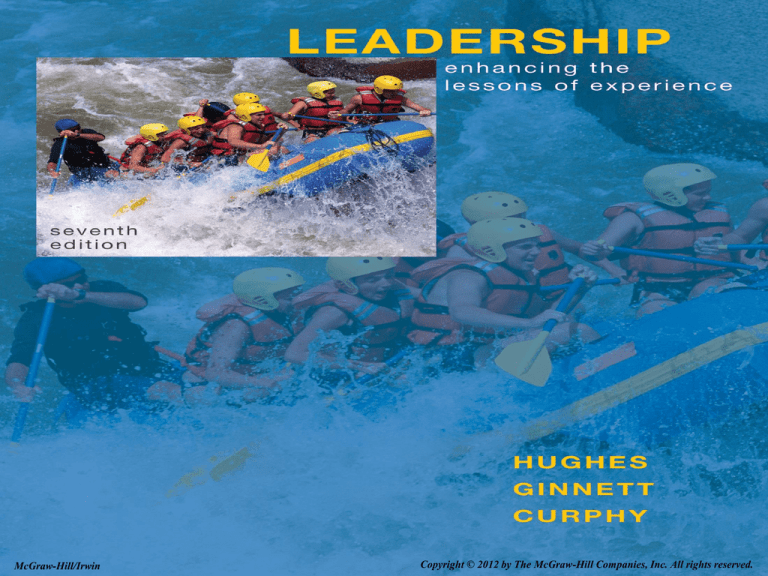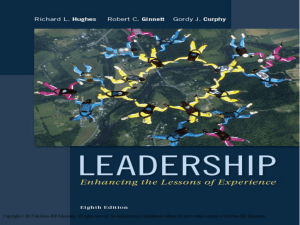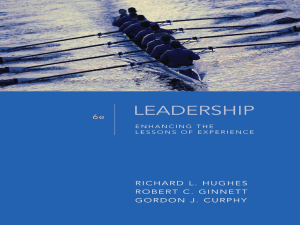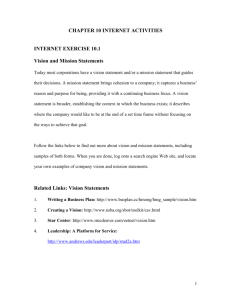
McGraw-Hill/Irwin
7-1
Copyright © 2012 by The McGraw-Hill Companies, Inc. All rights reserved.
Chapter
7
Leadership Behavior
“The truth of the matter is that you always know
the right thing to do. The hard part is doing it.”
Norman Schwartzkopf,
U.S. Army
7-2
Introduction
• One way to differentiate leaders is to look at
results.
• A key distinguisher between an effective
and ineffective leader is their everyday
behavior.
– Leadership behavior can be observed.
– Certain traits, values, or attitudes may
contribute to effective performance of some
leadaership behaviors.
• Two other factors that influence leadership
behavior are the followers and the situation.
7-3
Why Study Leadership Behavior?
• Many leaders either cannot build teams or
get results, or do not realize the negative
impact of their behavior.
• Leadership behaviors are a function of
intelligence, personality traits, emotional
intelligence values, attitudes, interests,
knowledge, and experience.
• Over time, leaders learn and discern the
most appropriate and effective behaviors.
– Individual difference and situational variables
play a pivotal role in a leader’s actions.
7-4
The Building Blocks of Skills
FIGURE 7.1
The Building Blocks of Skills
7-5
The Early Studies
• Ohio State University: Developed the Leader
Behavior Description Questionnaire (LBDQ)
and identified two independent dimensions of
behaviors:
– Consideration
– Initiating structure
• These dimensions were independent continuums.
• University of Michigan: Identified two
dimensions contributing to effective group
performance:
– Job-centered dimensions
– Employee-centered dimension
• These dimensions were at opposite ends of a
single continuum.
7-6
Alternative Conceptualizations of
Leadership Behavior
• Alternative conceptualizations are concerned
with:
– Identifying key leadership behavior.
– Determining if these behaviors have positive
relationships with leadership success.
– Developing those behaviors related to leadership
success.
• Leadership Grid: Profiles leader behavior on
two dimensions:
– Concern for people
– Concern for production
• The most effective leaders are said to have high
concern for both people and for production.
7-7
The Leadership Grid
FIGURE 7.2
The Leadership Grid
Source: Robert R. Blake and Anne Adams McCanse, Leadership Dilemmas—Grid Solutions (Houston: Gulf
Publishing, 1991), p. 29. Copyright 1991. Reprinted with permission of Grid International
7-8
Organizational Competency Models
• Every organizational competency model
falls into four major categories:
– Intrapersonal and interpersonal skills.
– Leadership and business skills.
• The Hogan and Warrenfelz model:
– Allows people to see connections between
various competency models.
– Makes predictions concerning level of difficulty in
changing various leadership behaviors and skills.
– Points out what behaviors leader must exhibit to
be effective.
7-9
Leadership Competency Model
FIGURE 7.3
An example of a
leadership competency
model.
Source: G.J. Curphy, K.
Louiselle, and S. Bridges:
Talent Assessment
Overview: 360-Degree
Feedback Report. Eagan,
MN: Advantis Research &
Consulting, 2003.
7-10
The Leadership Pipeline
• Model that shows where leaders should
spend time and what they should be
learning based on their organizational level
• Follows the leader’s development as they
progress through organizational levels from
first line supervisor up through to CEO
• Can create a roadmap for individuals who
want to chart their career progression
• Organizations can customize to fit their
organizational situation using competency
models.
7-11
The Leadership Pipeline
Organizational Level
Individual
contributor
First-line
supervisor
Midlevel
manager
Competency Requirements
Technical proficiency. Using
company tools. Build
relationships with team
members.
Planning projects. Delegating
work.
Coaching and feedback.
Performance monitoring.
Select, train, and manage firstline supervisors. Manage
boundaries and deploy
resources to teams.
Time Applications
Meet personal due dates.
Arrive/depart on time.
Work Values
Get results through personal
proficiency.
High-quality work. Accept
company values.
Annual budget planning.
Make time available for
followers. Set priorities for
team.
Get results through
others. Success of followers.
Success of the team.
Monitor performance of
each team. Make time to coach
first-line supervisors.
Appreciate managerial
versus technical work.
Developing first-line
supervisors.
Excerpt from TABLE 7.2
The Leadership Pipeline
Source: R. Charan, S. Drotter, and J. Noel, The Leadership Pipeline: How to Build the Leadership-Powered
Company (San Francisco: Jossey-Bass, 2001).
7-12
Community Leadership
• Community leadership: Process of building
a team of volunteers to accomplish some
important community outcome.
• Community leaders do not have position
power, and they also have fewer resources
and rewards.
• Three competencies needed to successfully
drive community change efforts:
– Framing
– Building social capital
– Mobilization
7-13
The Components of Community
Leadership
FIGURE 7.4
The Components of Community Leadership
Source: J. Krile, G. Curphy, and D. Lund, The Community Leadership Handbook: Framing Ideas, Building
Relationships, and Mobilizing Resources (St. Paul, MN: Fieldstone Alliance, 2006).
7-14
Assessing Leadership Behavior:
Multirater Feedback Instruments
• 360-degree (multi-rater feedback) tools
allow managers to get accurate information
about how others perceived their on-the-job
behaviors.
• Questionnaire construction very important.
• Leaders who received 360-degree feedback
had higher performing work units.
• 360-degree feedback systems can add
tremendous value when used for
development purposes.
7-15
Multirater Feedback Instruments
(continued)
• The key to high observer ratings is to
develop a broad set of leadership skills
that help groups accomplish goals.
• Research shows that it is possible to
change others’ perceptions of a leader’s
skills over time.
– Leaders must set development goals and
commit to a development plan to improve
skills.
• Societal or organizational culture, race, and
gender play key roles in the accuracy and
utility of the 360-degree feedback process.
7-16
Sources for 360-Degree Feedback
FIGURE 7.5
Sources for 360-Degree Feedback
7-17
Example of 360-Degree Feedback
FIGURE 7.6
Example of 360-Degree Feedback.
Source: K. Louiselle, G. J. Curphy, and S. Bridges, C3 360-Degree Feedback Report (Eagan, MN: Advantis
Research and Consulting, 2003). Reprinted with permission of Advantis Research and Consulting.
7-18
Summary
• Leaders can benefit from the leadership
behavior research in several ways.
• Research has helped to identify factors that can
cause high-potential managers to fail.
• The Leadership Grid provides taxonomy of
leader types based on behavioral orientation
• The Leadership Pipeline model allows
organizations to chart leader progression by
using customized competency models
• Community leadership allows accomplishment
of community oriented goals
• 360 degree feedback gives leaders feedback
useful in improving their performance.
7-19











